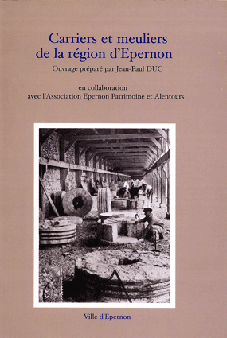


 Jean Paul Duc et Association Epernon Patrimoine et alentours
Jean Paul Duc et Association Epernon Patrimoine et alentours
Carriers et meuliers de la région d'Epernon
Edition Mairie d'Epernon - Idéogram
ISBN 2-87933-001-7
2005, 160 p.
Translation of title : Quarrymen and millstone makers of the Epernon region
This booklet of 160 pages was printed for the inauguration of the Conservatoire des meules et pavées du bassin d'Epernon (Museum of millstones and cobblestones of the Epernon basin). The work is divided in five sections : the extraction of sandstone, the manufacture of millstones, the social aspects and the tools. An final appendix presents a slate of the mutual companies, a bibliography and a list of operators that exploited the sites.
It was only recently that the millstone and cobblestone sandstone quarries halted production and the noise ceased and the dust cleared. These sites gave way to new factories that have now rekindled memories of the earlier productions. The ancient sandstone quarries are ancient : from Prehistory, Middle Ages and the Renaissance. The construction of the aqueduct that channelled water from the Eure River towards Versailles was the cause of a sudden increase in activity. Other products beside the cobblestones were then manufactured : troughs for pigs and millstones for local cider factories.
Concerning the question of millstone production, based on the few exploitations before the 19th century, one would never have envisioned a bright future for the site. But with the introduction of the railroad, the quarries of la Ferté-sous-Jouarre sought to consolidate their dominion in the region. A quarryman named Joseph Theil, possibly a representative of Société Générale Meulière (SGM) - the question is still not solved - produced samples of high quality.
At this moment the onrush for millstones began. The first were hewn from the hillsides of Villiers-le-Morhier (identified by the name Maintenon) and were not of high quality. But progressively they improved as the exploitations approached Epernon. Stones from the hills of Saint-Lucien were used a centre-pieces by enterprises such as Gaillar, Roger-fils or Dupety-Orsel. They were even exhibited from 1849 onwards in universal exhibitions. Progressively more and more personnel was transferred to Epernon from the Ferté region. This migration reached the point that about half of the total population was related millstone manufacture.
The workers were poor and hazards to their health, in addition to the abuse of alcohol, made life expectancy short. The fact that the town was near Paris also brought about the arrival of outcasts from the capital which gave the region a negative reputation. At the Ferté the millstone production shut down after the Second World War. At Epernon the first company to follow suit was Dupety-Orsel due to the fact that the Germans made fires in the centre hole (eye) of their millstones. Société Générale Meulière that Madame Colmont had preserved could not cope and was eventually taken over by the SOCAM of Chartres.
It was then that the Abrasienne company started producing composite millstones composed of emery, silica, cement and achromine. In 1964, in the midst of difficulties, it was acquired by the company SA Joyeau and reinvigorated. But then in 1970 it deserted Epernon. This spelt the end of the industry.

| Les partenaires de Meulières.eu |
